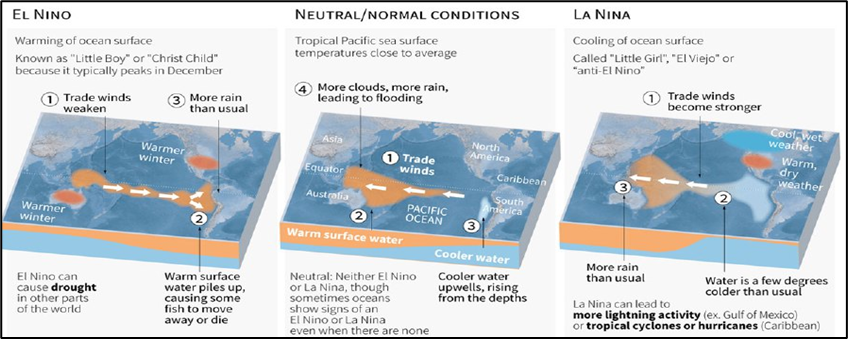Why in News?
This year's La Niña forecasts from all of the top international agencies were wildly inaccurate. In this context, there is a need to analyse the likely impact of delay in La Niña’s onset and why did global weather models get their predictions wrong.
What’s in Today’s Article?
- What is the Phenomenon of the El Niño Southern Oscillation (ENSO)?
- What is El Nino and La Nina?
- Comparing El Nino, La Nina with Normal Conditions
- Latest Predictions of La Nina and Impact of Delayed Onset on the Indian Monsoon
What is the Phenomenon of the El Niño Southern Oscillation (ENSO)?
- The ENSO is a phenomenon characterised by changes in sea temperatures along the tropical Pacific Ocean due to atmospheric fluctuations overhead.
- The ENSO has three phases - warm (El Nino), cool (La Nina) and neutral/normal, which occurs in irregular cycles lasting anywhere from two to seven years.
- Because it disrupts the global air circulation and affects weather patterns worldwide, ENSO is a major contributor to the variability of the natural climate on a global scale.
What is El Nino and La Nina?
- El Nino (or ‘The Little Girl’ in Spanish) and La Nina (or ‘The Little Boy’ in Spanish) are two opposing climate trends that deviate from the normal conditions and normally run 9 to 12 months.
- El Nino (which is more frequent than La Nina)) is typically known as the warm phase of ENSO, in which a band of warmer water spreads from west to east in the equatorial Pacific Ocean.
- On the other hand, La Nina is identified as the cold phase of ENSO, in which a band of cooler water spreads east-west in the equatorial Pacific Ocean.
- Both El Nino and La Nina can have global effects on weather, wildfires, ecosystems and economics.
Comparing El Nino, La Nina with Normal Conditions:

- During the neutral/normal phase, the eastern Pacific (off the northwestern coast of South America) is cooler than the western Pacific (around Philippines and Indonesia).
- This is because prevailing trade winds - caused by Earth’s rotation, between 30 degrees north and south of the equator - move east to west.
- This sweeps warmer surface water along with them and relatively cool waters from below rise to the surface to replace the displaced water.
- During the El Niño phase, these wind systems weaken, leading to lesser displacement of warmer waters off the American coasts.
- As a result, the eastern Pacific becomes warmer than usual.
- The opposite happens in the La Niña phase, trade winds become stronger than usual and push larger quantities of water to the western Pacific.
- In India, El Niño is associated with suppressed rainfall during the monsoon season, while La Niña is known to help monsoon activity.
- The effects of El Niño and La Niña-related risks, such as high temperatures, heavy precipitation, and droughts, have been intensified due to anthropogenic climate change.
Latest Predictions of La Nina and Impact of Delayed Onset on the Indian Monsoon:
- Latest Predictions of La Nina:
- One of the longest recorded La Niña episodes lasted from 2020 to 2023 and the previous El Niño event occurred between June 2023 and May 2024, following which ENSO entered the neutral phase.
- The latest predictions suggest that the earliest signs of the onset of La Niña will likely emerge by the end of September or in early October.
- La Niña would peak in November, and is expected to last throughout the winter in the northern hemisphere.
- Initial projections suggested that the onset of La Niña conditions would occur around July.
- The error in predicting La Niña’s onset is because of the fact that weather models are likely to better pick up signals in cases of strong La Niña or El Niño phases, rather than weak ones.
- Impact of Delayed Onset on the Indian Climate:
- Southwest monsoon (June - September):
- A delayed La Niña onset does not definitely mean an adverse monsoon performance. For example, the IMD predicted a 109% ‘above’ normal rainfall over most geographical areas this monsoon season.
- But there are wide variations in precipitation at the regional level. For example, almost every state in the east and the northeastern region have seen deficient rainfall.
- Northeast monsoon season (October - December):
- Also known as the winter monsoon, this is limited to Tamil Nadu, coastal Andhra Pradesh, Rayalaseema, southern interior Karnataka and Kerala.
- Though La Niña does not favour northeast monsoon rainfall, there have been exceptions in the past.
- Cyclogenesis:
- The north Indian Ocean basin - which covers the Bay of Bengal and the Arabian Sea - sees peak cyclone activity during May and November.
- During La Niña years, there are high chances of frequent cyclogenesis, with storms having above-average intensity and longer-than-average life.
- Winter season: La Niña years in the past have typically seen harsher, colder winters.









